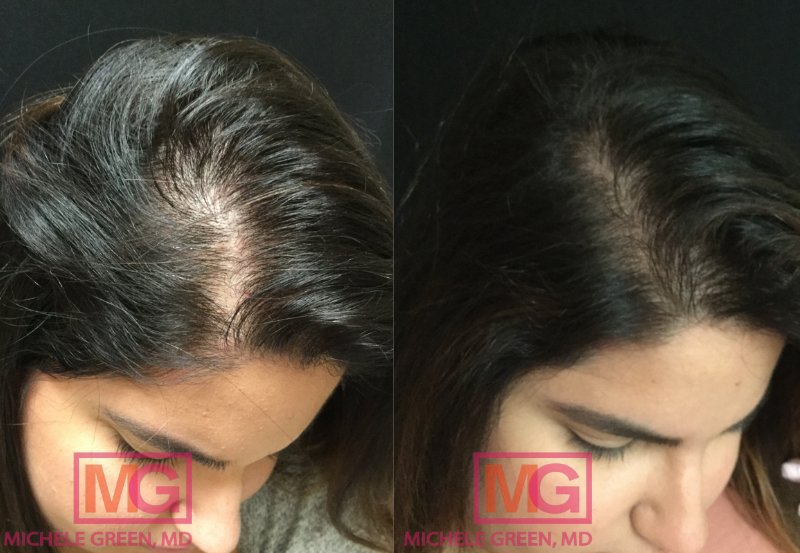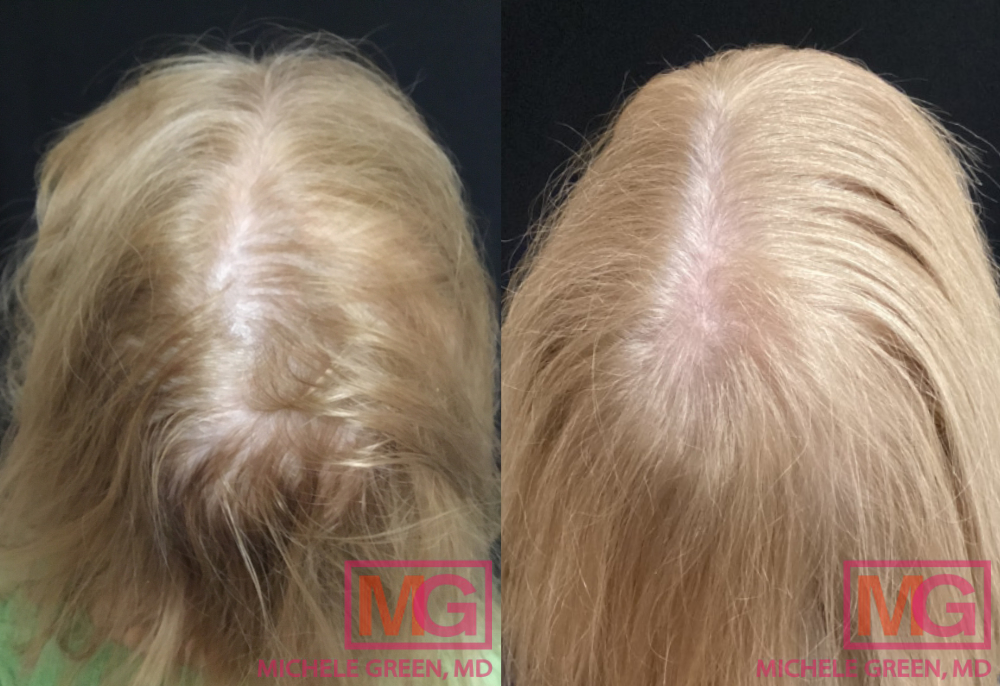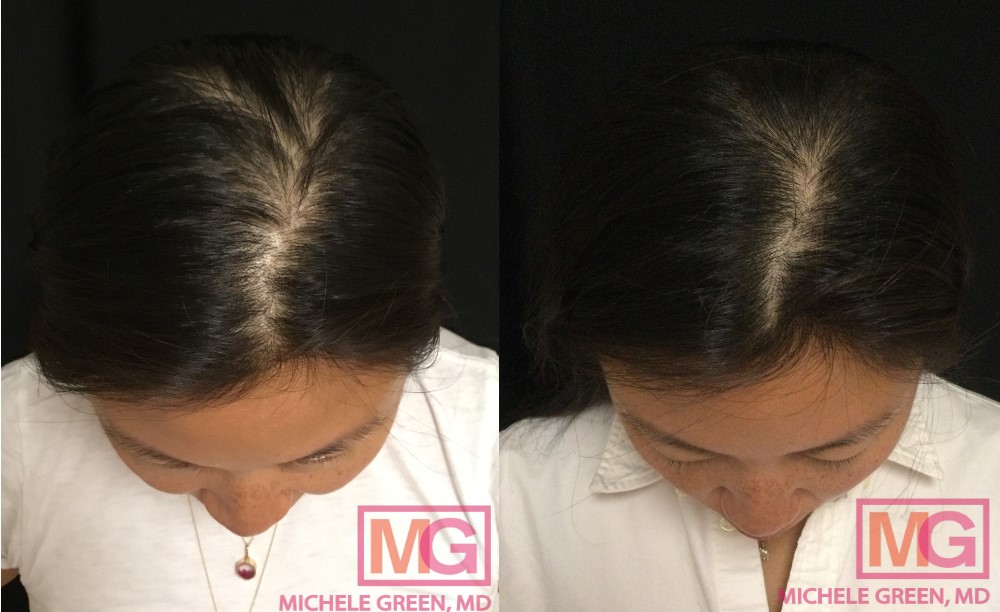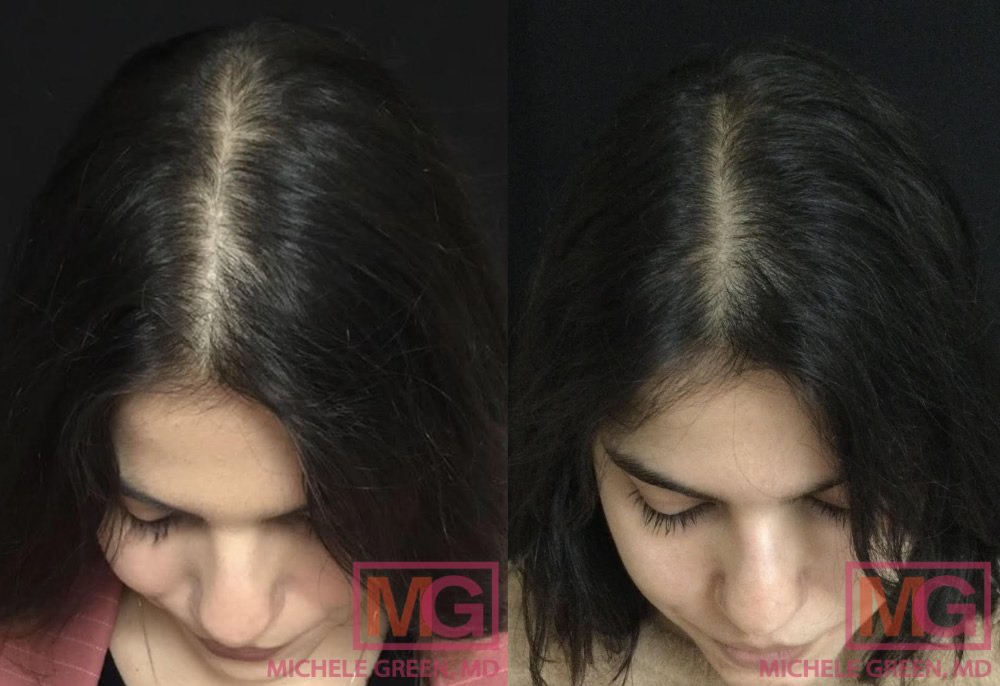Postpartum Hair Loss
Numerous changes occur when becoming a new mom, with the biggest and most exciting being the arrival of your new child. However, during the experience of pregnancy and birth, as well as in the months postpartum, a woman’s body undergoes many changes. In the third trimester of pregnancy, levels of the hormones estrogen and progesterone rise, which affects the hair growth cycle by preventing hair from entering the shedding phase. While this change in hormone levels results in lush, full hair during the third trimester, when estrogen and progesterone levels drop after birth, the hair that was in the resting phase begins to fall out, leading to increased hair shedding in the postpartum months. Many new moms notice clumps of hair on their pillows in the morning or find the shower drain clogged, which can be distressing. Fortunately, board-certified dermatologist Dr. Michele Green in NYC specializes in various forms of hair loss and can help you prepare for postpartum hair loss.
Postpartum hair loss is a common condition that arises from fluctuating hormone levels during and after pregnancy. It affects between 40% and 50% of all pregnant individuals and, unfortunately, cannot be prevented. However, this condition is only temporary, typically lasting from six to fifteen months after the birth of your child. During this period, Dr. Green offers several lifestyle recommendations to help reduce the appearance of thinning and shedding hair, which include specific hair care products and styling tips. For patients seeking to thicken existing hair and promote new growth, Dr. Green may suggest in-office treatments such as platelet-rich plasma injections to enhance hair follicle thickness and improve blood supply to the scalp. If you have questions about postpartum hair loss, the best first step is to schedule an initial consultation with experienced New York City dermatologist Dr. Michele Green.
Expert board-certified dermatologist Dr. Michele Green has been expertly treating patients in her Upper East Side dermatology office for over 25 years. By providing personalized advice and treatment plans, Dr. Green specializes in hair loss, including postpartum hair loss, telogen effluvium, thyroid conditions, alopecia areata, and androgenetic alopecia. Her goal is to diagnose the underlying cause of your hair loss and determine the optimal treatment to promote hair regrowth. Whether you’re looking for topical or oral options for hair loss or the best strategy to encourage new healthy hair growth, Dr. Green is ready to help.
What is postpartum hair loss?
Postpartum hair loss is a common condition that affects between 40% and 50% of individuals who have recently given birth. This condition is characterized by excessive shedding of hair in the months following childbirth. Some of the tell-tale signs of postpartum hair loss include noticing extra hair in the shower drain or on your pillow upon waking, which can be quite distressing. The thinning hair is often most apparent along the hairline and for those with longer hair. While the increased shedding can indeed be disconcerting, true postpartum hair loss is only temporary. The time it takes for hair to regrow and for the hair growth cycle to stabilize varies from person to person. It is challenging to predict who will experience postpartum hair loss, as the effects of pregnancy differ for everyone. Additionally, there is no definitive way to prevent or treat postpartum hair loss, although there are various lifestyle changes that can promote hair health and help mask the effects of the condition.
What causes postpartum hair loss?
Many patients wonder why postpartum hair loss occurs, and the answer lies in the fluctuations of pregnancy hormones. Your hair naturally goes through cycles of growth, rest, and shedding, with the average person losing about 100 hairs a day. At any moment, between 85 and 95 percent of the hair on your head is in the anagen or growth phase. Hairs are primarily in the growth phase and can stay in it for two to six years. This means that between 5 and 15 percent of the hair on your head is in the resting stage, which typically lasts for three to four months, after which shedding begins to make way for new hair growth. However, to understand why excessive shedding happens after pregnancy, it’s essential to examine what occurs with your hair during pregnancy.
During pregnancy, levels of estrogen rise in the body, which can affect a variety of functions in your body, including the cycle of hair growth and shedding. While estrogen levels are high, your hair remains in the resting stage and does not move into the shedding stage. So, the thick mane of hair during pregnancy is not the result of an increase in hair growth but rather an increase in hair retention. During pregnancy, estrogen levels rise in the body, impacting various functions, including the hair growth and shedding cycle. While estrogen levels are elevated, your hair remains in the resting stage and does not transition to the shedding stage. Therefore, the thick mane of hair during pregnancy results not from increased hair growth but from enhanced hair retention. After childbirth, hormone levels return to pre-pregnancy levels, leading to a drop in estrogen. This change triggers the hair shedding phase, which naturally follows the resting phase, resulting in a larger amount of hair loss than usual and causing excessive shedding. This higher-than-average hair loss is known as telogen effluvium.
It takes time for hormone levels to regulate after giving birth. Many patients begin to notice postpartum hair loss up to three months after giving birth. Your hair naturally goes through cycles of growth that consist of the growth phase, the resting phase, and the shedding phase. During pregnancy, rising hormone levels, such as increased estrogen and progesterone, cause hair that would normally move to the shedding phase to stay in the resting phase. After birth, when the hormone levels fall, the hair that remains in the resting phase during pregnancy will move into the shedding phase, meaning that there is a higher-than-typical amount of hair that is moving into the shedding phase, leading to more hair loss. This shift to the shedding phase, where hair falls out, can occur between three and five months after giving birth. While the start of the condition is variable from person to person, on average, this is when significant hair loss begins to occur postpartum.

PRP for hair – 2 sessions, 6 months
How long does postpartum hair loss & shedding last?
The duration of postpartum hair loss varies, but the condition is temporary, and hair should fully grow back over time. New moms typically start to notice excessive hair shedding within three months of giving birth, as estrogen levels drop and hair transitions from the resting phase to the shedding phase. Not all hair follicles that enter the resting stage during pregnancy will enter the shedding phase simultaneously, so excessive shedding can persist from six to fifteen months postpartum. Following this extended shedding phase, hair regrowth will occur, and your hair should return to its pre-pregnancy growth cycle. Some individuals find that while regrowth has occurred, their hair may not return to the same density it had before pregnancy, and others may notice a change in hair texture.
When does postpartum hair loss peak?
For most people experiencing postpartum hair loss, the peak of excessive hair shedding occurs four to five months after giving birth. Many patients report that their hair is thick and lush during the third trimester, when estrogen levels rise, preventing hair loss. Typically, postpartum hair loss begins three to five months after birth. As estrogen levels decline, the hair that remains in the resting phase during the final trimester of pregnancy enters the shedding phase of the growth cycle, resulting in a higher-than-normal amount of hair shedding at once. This prolonged shedding phase can last up to fifteen months, but most patients see a return to their regular growth cycle within a year of delivery birth.
When does postpartum hair loss stop?
The effects of postpartum hair loss—excessive shedding of hair—cease after the hair follicles that remained in the resting (catagen) stage during pregnancy have completed their shedding phase. Following this shedding phase, regrowth occurs, though often the hair does not return as densely as before, and the texture may have changed. The shedding phase of hair that was arrested in the resting stage during pregnancy typically concludes between six and fifteen months after birth. In other words, postpartum hair loss should end after six to fifteen months. If hair loss continues beyond fifteen months, it may be time to consult a board-certified dermatologist, as other factors may be contributing to your hair loss.

How long does postpartum hair shedding last?
Alopecia is a condition in which hair is lost from areas where it would typically grow. Postpartum hair loss can be a type of alopecia called telogen effluvium. This temporary hair loss condition occurs after a stressful event, such as pregnancy or childbirth. Typically, a transient issue that starts three to four months after the stressor resolves, telogen effluvium, can last for up to a year. Postpartum hair loss improves once the growth cycle returns to normal. Most patients find that the condition of their hair resolves by the time the child turns one.
Does hair grow back after postpartum hair loss?
Yes! Postpartum hair loss is a temporary condition that resolves over time. The hair loss that occurs, results from the shedding phase of the hair growth cycle, which happens to make room for new growth. Consequently, the hair lost during postpartum hair loss will grow back, though it may not have the same density as before pregnancy. If alopecia, or excessive hair loss, persists for longer than fifteen months postpartum, it is advisable to consult an expert dermatologist, such as Dr. Michele Green. Prolonged hair loss may indicate other underlying issues, including thyroid problems, genetics, or vitamin deficiencies. If you have any questions about your postpartum hair loss, you can schedule a consultation with Dr. Green, who can advise you on the best methods to promote new hair growth.
How can I stop postpartum hair loss?
Postpartum hair loss occurs due to the sudden drop in levels of the hormones estrogen and progesterone after your baby is born. While elevated levels of these hormones during the third trimester keep your hair in the resting phase, the sharp decline in estrogen and progesterone levels causes more hair than usual to enter the shedding phase, leading to more noticeable hair loss. This can be quite distressing, but unfortunately, there are no methods to prevent postpartum hair loss from happening. The hormonal changes during pregnancy that lead to postpartum hair loss are normal and essential for a healthy pregnancy. Fortunately, this condition is only temporary, and your hair growth cycle should return to normal within a year of giving birth.
How to reduce postpartum hair loss
Although it may not be entirely preventable, postpartum hair loss symptoms can be minimized through certain lifestyle changes. First, it is crucial to select hair products that won’t weigh down the hair, as this can accentuate the appearance of thinning locks. Instead, individuals should opt for volumizing shampoos to enhance hair thickness and use lightweight conditioners to hydrate without adding extra weight. Additionally, it is advisable to avoid hair dryers and tight hairstyles, such as ponytails and braids, which can tug on the hair and contribute to increased hair loss. Moreover, maintaining a nutritious diet that is rich in protein, iron, and Vitamin C is important for promoting the health of hair follicles, leading to stronger and thicker new hair growth.
Women who are not Women who are not breastfeeding can benefit from a hair loss treatment known as platelet-rich plasma (PRP). PRP, or platelet-rich plasma, is an advanced stem cell technology obtained by drawing the patient’s blood and centrifuging it to separate the plasma from red blood cells. The plasma has a platelet concentration three times higher than the normal level and contains numerous growth factors that stimulate the regenerative cells surrounding the hair follicles. The PRP is then injected into different areas of the scalp to encourage hair growth and revitalization. While the PRP treatment cannot prevent hair shedding, it can accelerate hair growth, providing patients with thicker, healthier hair after experiencing postpartum hair loss. When you consult with Dr. Green, she will carefully gather your medical history and assess your hair loss situation to determine if you are a suitable candidate for PRP injections.
How to prevent losing hair after pregnancy
There is nothing that can be done to stop postpartum hair loss, but it can be helpful to consult with an expert dermatologist, such as Dr. Michele Green, who can help prepare you for the symptoms. If you are worried about the effects of postpartum hair loss, a great first step is to schedule an initial consultation with Dr. Green, who can walk you through the stages of the condition and generate a treatment plan that will be safe for you and your baby. The hair loss condition is temporary, and your hair growth cycle should be back to normal within 6 to 15 months.
While postpartum hair loss usually resolves on its own, patients who are not breastfeeding can speed up their recovery with PRP treatments. Platelet-rich plasma (PRP) is a unique hair loss therapy that uses the growth factors in your blood to stimulate new hair growth and prevent further loss. PRP is extracted from a sample of the patient’s blood and injected into various areas of the scalp to encourage hair growth. Typically, a series of four treatments spaced one month apart, followed by maintenance sessions, is required to start the hair regrowth process.
How do you stop hair loss after giving birth? How do you prevent postpartum hair loss?
Postpartum hair loss is, unfortunately, a condition that cannot be prevented. It is a temporary issue caused by hormonal fluctuations that occur during and after pregnancy. There isn’t a guaranteed method for preventing this type of hair loss. However, most people find that their hair returns to its natural state by the time their baby reaches one year old, with hair loss and shedding improving around six months postpartum. You can minimize the severity and promote healthy hair by maintaining a well-balanced diet and continuing to take prenatal vitamins. To reduce the risk of hair loss, it is advisable to avoid products that cause hair breakage, especially hot styling tools like straightening irons, blow dryers, or curlers. Dr. Green also recommends avoiding hairstyles that pull on the scalp, such as tight ponytails and braids. Various hair care strategies can help lessen the effects and visibility of postpartum hair loss, including using volumizing shampoos and light conditioners and experimenting with different hairstyles. Women who are not breastfeeding can encourage hair regrowth and address postpartum hair loss through PRP treatments. Platelet-rich plasma promotes hair regrowth and thickness, helping new moms achieve thicker, healthier hair swiftly.

PRP for hair – 3 sessions, 3 months
Treatment of postpartum hair loss
According to the According to the American Academy of Dermatology, many patients notice visible improvement in their hair by their baby’s first birthday. However, there are times when hair regrowth after childbirth does not follow this trend and happens more slowly than desired. It is important to continue taking prenatal vitamins, maintain a healthy diet, and check other vitamin levels and hormone levels to ensure that pregnancy hormones have returned to normal. Dr. Green will conduct a thorough assessment of your hair, scalp, and medical history to determine that the cause of your hair loss is not related to any systemic conditions, such as lupus or other autoimmune diseases.
If you are not breastfeeding, Dr. Green may recommend other treatments for your hair loss, such as platelet-rich plasma (PRP), to thicken your existing hair and encourage new hair growth. The procedure involves collecting a sample of the patient’s blood and spinning it in a centrifuge to separate the red blood cells from the plasma. The plasma contains a highly concentrated volume of platelets packed with growth factors, collagen, and other nutrients. Dr. Green injects the plasma into areas of hair loss to stimulate new hair growth. To determine if PRP injections are the best treatment option for you, schedule an initial consultation with expert dermatologist Dr. Michele Green.
What helps with postpartum hair loss?
Many patients wonder how to reduce the appearance of postpartum hair loss. Although this condition cannot be prevented, several methods can minimize or mask its symptoms. These hair care strategies involve straightforward lifestyle changes that can help maintain hair or lessen the visibility of hair loss.
Hair Care Products: When aiming to strengthen your hair, a volumizing shampoo can be beneficial. These shampoos typically contain ingredients like biotin, which coats the hair to fortify the hair follicle and enhance the fullness of your hair. Additionally, products that keep your hair moisturized, such as mousse, can also promote a fuller look. It’s important to avoid “conditioning shampoos” or any heavy conditioners, as they can weigh down the hair, further accelerating hair loss. Instead, look for a conditioner designed for fine hair, as these will be gentler on the hair follicles and won’t weigh your hair down.
Hair Styling: If you’re coping with postpartum hair loss, a trip to the stylist may be helpful. This type of hair loss often occurs along the hairline framing the face. Therefore, a middle part hairstyle with longer bangs designed to frame the face can make hair loss more noticeable. A haircut featuring bangs along the forehead and plenty of layers can effectively conceal hair loss at the hairline. Moreover, wearing your hair curly may mask the loss better than straight styles. Stylists also recommend using accessories like headbands or headscarves to cover up areas of hair loss.
What are the causes of postpartum hair loss?
Postpartum hair loss is a common condition that can affect new mothers. Throughout pregnancy, hormone levels fluctuate, causing various changes in the body. Estrogen levels rise, leading to increased hair retention, meaning that hairs in the resting phase do not shed and instead remain in place. Many individuals experience “pregnancy hair,” which refers to hair that appears fuller due to this increased retention. After giving birth, hormone levels begin to normalize, resulting in decreased estrogen levels. With lower estrogen, the hair that was previously retained starts to fall out. Since many hairs cannot shed during pregnancy, there’s an uptick in hair shedding afterward, known as postpartum hair loss. This hair loss is temporary, as the hair follicles revert to the growth phase, and the hair cycle returns to normal.
Does postpartum hair loss happen to everyone?
While postpartum hair loss does not occur in everyone, it is a common condition—almost half of all individuals who have given birth experience hair loss after childbirth. Since everyone’s hormonal changes vary, the severity and duration of the condition differ from person to person. It can be challenging to predict whether postpartum hair loss will happen, and some people may find that hair loss occurs after one pregnancy but not another. Does collagen help with p?
Collagen is a protein naturally found in the body. It provides structure and strength to the skin, hair, and joints. As we age, collagen production decreases, resulting in sagging skin and dull, thinning hair. In recent years, collagen supplements have gained popularity due to their essential role in achieving a youthful appearance. Collagen is vital for strengthening hair, which leads many patients to wonder if collagen supplements can help with postpartum hair loss. Some claim that taking collagen supplements can stimulate new hair growth following hair loss and strengthen hair for a fuller appearance.
Before taking any supplements, consult your OBGYN. Many supplements are not regulated by the US Food and Drug Administration, meaning there is little oversight to ensure they are safe and effective for pregnant or breastfeeding individuals. For your safety and your baby’s safety, it is crucial to get approval from your OBGYN before consuming any supplements or medications, especially since side effects could be harmful.
Does Nutrafol work for postpartum hair loss?
Nutrafol is a supplement designed with various vitamins and nutrients that can promote hair growth. Individuals with deficiencies in biotin, iron, vitamin C, vitamin D, or zinc may experience thinning hair or a dull appearance. Nutrafol contains all of these nutrients and can boost their levels to an adequate range for healthy hair growth. While Nutrafol is an excellent option for those experiencing hair loss, it’s essential to consult your OBGYN before using it for postpartum hair loss. The health and wellness of your baby should be the top priority, so getting approval from your OBGYN before starting any supplements is crucial.
Hair tourniquets from hair loss
One thing to be aware of as a new mom, especially if you are dealing with postpartum hair loss, is hair tourniquets. A hair tourniquet occurs when a hair falls out and gets wrapped around your baby’s finger, toe, or any other body part. The strands of hair wrapped around that area can cut off circulation to that area for your baby. If you notice your baby crying for an unknown reason, check their hands and feet for a hair tourniquet. If you find one, carefully remove it by gently unraveling it. If you cannot locate the loose end to unravel it, gently cut it off with small scissors. If you have difficulty removing the tourniquet, seek help from a healthcare professional immediately.

PRP for hair – 4 sessions, 4 months
How do I get started today with treatment for my postpartum hair loss?
During pregnancy, many patients find that their hair is thicker and fuller than ever before. During pregnancy, many patients find their hair thicker and fuller than ever before. However, after giving birth, between 40% and 50% of women may experience the concerning condition of postpartum hair loss. Hormonal changes during pregnancy and the postpartum period can result in excessive shedding and hair loss in the months following childbirth. Fortunately, postpartum hair loss is typically a temporary condition. For those who continue experiencing hair loss, Dr. Green’s private dermatology office offers various hair restoration treatment options to promote thicker, fuller, and healthier hair, including topical Rogaine and platelet-rich plasma (PRP) treatment. Patients can also consult Dr. Green for the most effective hair care treatments to minimize the appearance of excessive shedding until the hair growth cycle normalizes, including suitable shampoos and conditioners for everyday use.
Dr. Michele Green is an internationally recognized expert in treating hair loss, whether it’s related to postpartum changes or other hormonal or metabolic shifts. Dr. Green specializes in hair loss treatments, including Platelet Rich Plasma (PRP), and she customizes each patient’s treatment plan to meet their specific needs and goals best. She is consistently recognized as one of New York’s top healthcare providers by Castle Connolly, New York Magazine, and Super Doctors for her commitment to her patients and her expertise. Addressing the early signs of hair thinning is crucial for achieving optimal results. If you are experiencing postpartum hair loss or other types of hair loss, please schedule a consultation with Dr. Michele Green today by calling (212) 535-3088 or contacting her online.
 212-535-3088
212-535-3088